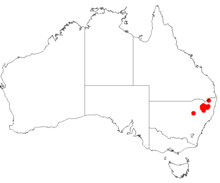Homoranthus prolixus
Homoranthus prolixus is a plant in the myrtle family Myrtaceae and is endemic to northern New South Wales. It is a spreading shrub with linear to lance-shaped leaves and groups of up to six yellow to red flowers in the upper leaf axils.[2][3][4]
.jpg)
| Granite homoranthus | |
|---|---|
 | |
| Homoranthus prolixus in the ANBG | |
| Scientific classification | |
| Kingdom: | Plantae |
| Clade: | Tracheophytes |
| Clade: | Angiosperms |
| Clade: | Eudicots |
| Clade: | Rosids |
| Order: | Myrtales |
| Family: | Myrtaceae |
| Genus: | Homoranthus |
| Species: | H. prolixus |
| Binomial name | |
| Homoranthus prolixus | |
 | |
| Occurrence data from AVH | |
| Synonyms[1] | |
|
Homoranthus bornhardtiensis J.T.Hunter | |
Description
Mostly ascending growth habit. Flowers September to December and fruits September to January.[5]
Taxonomy and naming
Homoranthus prolixus was first formally described in 1991 by Lyndley Craven and S.R.Jones and the description was published in Australian Systematic Botany.[6][7] The specific epithet (prolixus) is a Latin word meaning "stretched out" or "long".[8]
Distribution and habit
Grows from Inverell to Bendemeer in northern New South Wales in woodland and heath on shallow sandy soils on and around granite or acid volcanic outcrops.[5]
Conservation status
Considered vulnerable by Briggs and Leigh (1996) but now know to be well reserved and often locally abundant. ROTAP conservation code of 3RCa more appropriate.[5]
References
- "Homoranthus prolixus". World Checklist of Selected Plant Families (WCSP). Royal Botanic Gardens, Kew.
- Harden, Gwen J. "Homoranthus prolixus". Royal Botanic Garden Sydney. Retrieved 25 August 2018.
- "Approved conservation advice for Homoranthus prolixus" (PDF). Australian Government Department of the Environment. Retrieved 25 August 2018.
- "Granite homoranthus - profile". New South Wales Government Office of Environment and Heritage. Retrieved 25 August 2018.
- Copeland, Lachlan M.; Craven, Lyn A.; Bruhl, Jeremy J. (2011). "A taxonomic review of Homoranthus (Myrtaceae: Chamelaucieae)". Australian Systematic Botany. 24 (6): 351. doi:10.1071/SB11015.
- "Homoranthus prolixus". APNI. Retrieved 25 August 2018.
- Craven, Lyndley A.; Jones, S R. (1991). "A taxonomic review of Homoranthus and two new species of Darwinia (both Myrtaceae, Chamelaucieae)". Australian Systematic Botany. 4 (3): 525–526. doi:10.1071/SB9910513.
- Brown, Roland Wilbur (1956). The Composition of Scientific Words. Washington, D.C.: Smithsonian Institution Press. p. 494.
